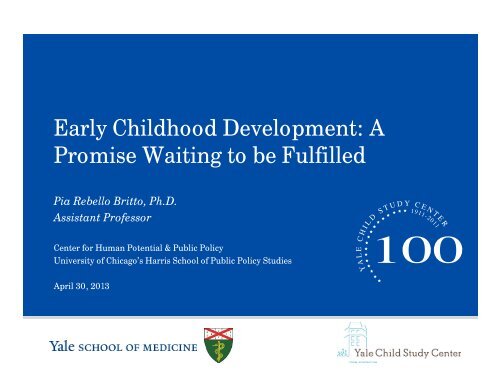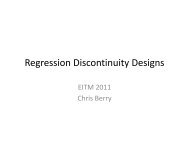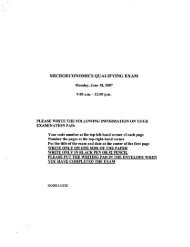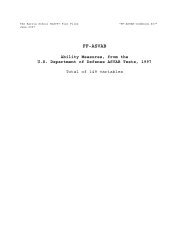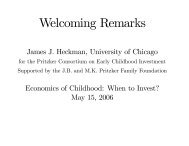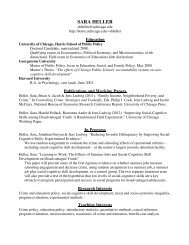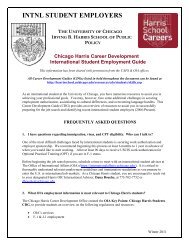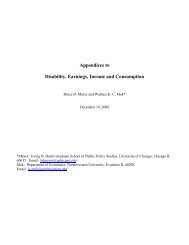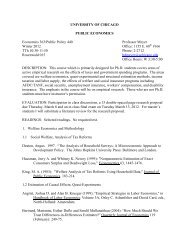PDF of Professor Britto's Presentation - Harris School of Public ...
PDF of Professor Britto's Presentation - Harris School of Public ...
PDF of Professor Britto's Presentation - Harris School of Public ...
- No tags were found...
Create successful ePaper yourself
Turn your PDF publications into a flip-book with our unique Google optimized e-Paper software.
Early Childhood d Development: APromise Waiting to be FulfilledPia Rebello Britto, Ph.D.Assistant Pr<strong>of</strong>essorCenter for Human Potential & <strong>Public</strong> PolicyUniversity <strong>of</strong> Chicago’s <strong>Harris</strong> <strong>School</strong> <strong>of</strong> <strong>Public</strong> Policy StudiesApril 30, 2013S L I D E 0
Britto, P. R., Yoshikawa, H., & Boller, K. (2011). Quality <strong>of</strong> early childhood development programs in global contexts: Rationale forinvestment, conceptual framework and implications for equity. Social Policy Report. Vol. 25, No. 2.S L I D E 5
A National ECD PolicyBritto, P.R. & van Ravens, J. (2007)S L I D E 6
ECD Policy FrameworkBritto, P.R., Cerezo, A., & Ogbunugafor, B. (2008)S L I D E 7
Convention on the Rights <strong>of</strong> the ChildHistorical Background• It arose in the 1970s as a reaction to the weakening global l humanitarianresponse to children.• The United Nations unanimously endorsed the convention on November20, 1989• It became international law in 1990.• The most widely ratified human rights treaty in United Nations historyS L I D E 8
Convention on the Rights <strong>of</strong> the Child:Overview• Focuses on the rights <strong>of</strong> the child from a developmental ecologicalperspective.• Assumption is: the child's overall development is a function <strong>of</strong> a number <strong>of</strong>factors and contexts– Factors:• psychological; social; educational; & cultural– ContextsHome; <strong>School</strong>; Community & Country• A universally agreed set <strong>of</strong> non-negotiable standards and obligations• Founded on respect for the dignity and worth <strong>of</strong> ALL children -- regardless<strong>of</strong> race, color, gender, language, religion, opinions, origins, wealth, birthstatus or ability• Incorporates the full range <strong>of</strong> human rights:– civil; cultural; economic; political; and social rights– Comprised <strong>of</strong> 54 articlesS L I D E 9
Convention on the Rights <strong>of</strong> the Child:Principles• Four Principles– Life, Survival and Development– Non Discrimination– A Child’s Best Interest– Participation – Child’s opinion• Three types <strong>of</strong> Rights to safeguard and uphold children's minimal rights– Provision i – for survival and development– Protection - harmful influences, abuse and exploitation– Participation– “agents <strong>of</strong> change”S L I D E 10
Life, Survival & DevelopmentThe inherent right to lifeThe right to an adequate standard <strong>of</strong> livingthat ensures children’s physical andemotional needs are fulfilledAccess to safe, clean drinking water andnutritious foodThe right to grow up healthy and receivequality medical careProper treatment and care for childrenafflicted with disabilities or victimized byabuse and neglect.Source: University <strong>of</strong> South Florida,Division <strong>of</strong> Child DevelopmentS L I D E 11
Convention on the Rights <strong>of</strong> the Child:Provision• Examples <strong>of</strong> articles seek to safeguard and uphold children's minimal:– Civil Rights• Article 7: The child shall be registered immediately after birth and shall have the rightfrom birth to a name, the right to acquire a nationality and, as far as possible, the rightto know and be cared for by his or her parents– Development Rights• Article 27: States Parties recognize the right <strong>of</strong> every child to a standard <strong>of</strong> livingadequate for the child’s physical, mental, spiritual, moral and social development– Health Rights• Article 24: States Parties recognize the right <strong>of</strong> the child to the enjoyment <strong>of</strong> thehighest attainable standard <strong>of</strong> health and to facilities for the treatment <strong>of</strong> illness andrehabilitation <strong>of</strong> health– Education Rights• Article 28: States Parties recognize the right <strong>of</strong> the child to educationS L I D E 12
Country Level Application <strong>of</strong> the RightsLevels <strong>of</strong>Duty bearers13S L I D E 13
What is the status <strong>of</strong> the CRCin the United States?The U.S. assisted in the drafting <strong>of</strong> the CRC during the ReaganAdministration.Provisions in the CRC calling for a child’s right to freedom <strong>of</strong> thought,speech, association, religion, and privacy not only reflect U.S. ideals, theywere mainly incorporated into the Convention by U.S. delegates at the request<strong>of</strong> President Reagan.In 1995, President Bill Clinton authorized Secretary <strong>of</strong> State MadeleineAlbright to sign the CRC signifying the U.S.’s intent to consider ratification.To date, the CRC has not been presented to the U.S. Senate which mustapprove a treaty by a two-thirds vote before a president can ratify it.S L I D E 14
tyDesign: Adrián Cerezo, Yale UniversitS L I D E 16
tyDesign: Adrián Cerezo, Yale UniversitS L I D E 17
tyDesign: Adrián Cerezo, Yale UniversitS L I D E 18
tyDesign: Adrián Cerezo, Yale UniversitS L I D E 19
tyDesign: Adrián Cerezo, Yale UniversitS L I D E 20
tyDesign: Adrián Cerezo, Yale UniversitS L I D E 21
tyDesign: Adrián Cerezo, Yale UniversitS L I D E 22
tyDesign: Adrián Cerezo, Yale UniversitS L I D E 23
Part 2: Situation <strong>of</strong> ECDServicesNeed for Scale UpS L I D E 24
Situation <strong>of</strong> Services• There is a growth in services for young children and families– ~ 42 program evaluations (Engle, et. al., 2011)Engle, Rao, & Petrovic, 2013S L I D E 25
Growing Global ECD EvidenceS L I D E 26
(UNICEF, 2011)S L I D E 27
What is the Problem?• Evidence-based strategies are necessary but insufficient conditions forscaling up• Most work on ECD has examined it from a service level, i.e., the contextand setting where the programs are delivered with little to no attentiongiven to the larger organizational and institutional structures withinwhich the ECD services are situated (Britto, Engle & Super, 2013)S L I D E 28
Identified Areas <strong>of</strong> Need•Little understanding <strong>of</strong> systems approach to scaling up <strong>of</strong> ECD• Services are strengthened by strengthening systems (Bradley, et al., 2011)• The potential <strong>of</strong> the system creates the opportunity to achieve the desired d outcomes(Berman, et al., 2011)• Understanding how systems operate, their strengths, and entry points can enable effectivedelivery <strong>of</strong> integrated ECD services• Limited inquiry into governance <strong>of</strong> ECD• Defined importance for other systems, e.g., health, nutrition (Bradley, Pallas, Bashyal,Berman, & Curry, 2010; Perez-Escamilla, 2012)• Coordination between sectors and actors is critical for integration (Yoshikawa, Rosman &Hsueh, 2002)S L I D E 29
Governance <strong>of</strong> ECD ServicesS L I D E 30
Conceptual Framework: Governance <strong>of</strong> the SystemProcess <strong>of</strong> allocating responsibility for ECD services within and across levels <strong>of</strong>government and between public and private sectors (Britto, et al., in press)– Horizontal – across sectors at the same level (Homsi & Hussein, 2013)– Vertical --Decentralization across levels (UNDP, 2010)– <strong>Public</strong> and private partnerships across sectors (Woodhead et. al., 2008)Functions, include: design and development, implementation, monitoring andinspection, supervision, and coordination (Kaufmann, Kraay & Mastruzzi, 2004;UNESCO, 2012)Situated within larger political, public policy, cultural and economic contexts(Yoshikawa & Currie, in press)– Environmental conditions – distribution <strong>of</strong> political power, prevailing marketstructures, cultural and community norms, etc. (Bermanm et al., 2011)– Capabilities: Capacity <strong>of</strong> knowledge; Capacity <strong>of</strong> practice (Hommel, 2013)System = Supply side + Demand side (World Bank, 2004)S L I D E 31
Study DescriptionAim: To explore the governance mechanisms required to strengthen nationalsystems <strong>of</strong> ECD services by using a comparative approach across multiple low andmiddle income country y( (LMIC) contextsResearch Questions:– Who are the main actors in ECD and what role do they play in the governance<strong>of</strong> national systems?– What are the coordination mechanisms for the governance functions <strong>of</strong>planning and development, implementation and delivery, monitoring,finance, inspection and supervision i for ECD services?• between sectors <strong>of</strong> government• Between government, non-government and private (for pr<strong>of</strong>it)• between national and sub-national level structures <strong>of</strong> the system– Which level <strong>of</strong> the system provides an entry point for integrated ECD services?– What is the beneficiary perspective on ECD services with respect to equity,access and quality?Design: Multi-country exploratory qualitative studyS L I D E 32
Sample• Where –Geographic:– Global regions <strong>of</strong> the world– Two countries within each global region (LMIC)– Three sub-national regions within each country• Who - Respondent:– System – Individuals who are part <strong>of</strong> the system that supports theprovision <strong>of</strong> the service, but do not directly provide services.– Service Provider – individuals who directly provide services to childrenand families, e.g., teachers, nurses, midwives– Beneficiaries – Families and children who receive the services• What – Services:– Health – e.g., immunization, nutrition– Social protection – e.g., conditional cash transfer– Education – e.g., formal pre-school, community preschoolS L I D E 33
Geographic Sample: Global Regions & CountriesS L I D E 34
Geographic Sampling FrameS L I D E 35
Geographic Sample: Within Country - KenyaPercentage <strong>of</strong> Malnourished Children Under Age 5(vertical) by Poverty Rate (horizontal) for KenyanProvincesSources: Kenyan Integrated t Household Budget Survey <strong>of</strong> 2005-2006 and DHS 2008/2009 (Kenya National Bureau <strong>of</strong>Statistics et al, 2010:145)S L I D E 36
Systems (See matrix for complete selection criteria)Represents the main division ordepartment that provides ECS (i.e. MIN. EDU)Represents the main division or departmentthat provides ECS (MIN. HEALTH)Represents the main division or departmentthat provides ECS (MIN CHILD/SOPCIAL PROTECTION)Represents sectors important in supporting national planning(MIN. NATIONAL PLANNING, FINANCE).National (central level)National Coordinating Body?NGO/Private/Other (National level)International NGOLocal national NGOAcademic organizations crucialfor training <strong>of</strong> ECD specialistsMonitoring institutionsRepresents the main division i i ordepartment that provides ECS in the Region (Education)Represents the main division or departmentthat provides ECS in the Region (Health)Regional (Lima, Ayacucho, Loreto)Represents the main division or departmentthat provides ECS in the Region (Protection)Represents sectors important in supporting national planning, ,decision-making (i.e . *Governor’s <strong>of</strong>fice).Regional Coordination Body?Represents the main division ordepartment that provides ECS in the province (i.e. Education)Represents the main division or departmentthat provides ECS in the province (Health)Represents the main division or departmentthat provides ECS in the province (Protection)Represents sectors important in supporting provincialplanning, decision-making (i.e. *Governor’s <strong>of</strong>fice).Provincial (one representative eprovince per region)Provincial Coordinating Body?NGO/Private & Service LevelInternational NGOLocal national NGORepresents the main division ordepartment that provides ECS in the municipality (Education)Represents the main division or departmentthat provides ECS in the municipality (Health)Represents the main division or departmentthat provides ECS in the municipality (Protection)Represents sectors important in supporting municiapalplanning (i.e. Office <strong>of</strong> the Mayor).Municipal (one representativemunicipality per provinceMunicipal Coordinating Body?Beneficiaries 1-2 FGDsEarly childhood health service providerEarly childhood education serviceproviderChild protection service providerECD program specific toMunicipalityS L I D E 37
Respondent Sample• Across 5 countries• Semi-structured interviews (N= ~ 210) with key informants atselected national and decentralized levels <strong>of</strong> system and services• Focus group discussions with beneficiaries (N=~ 40)– Some FGD = village center/town hall meetingsS L I D E 38
Sectors & Services Sample• Selection– Content analyses <strong>of</strong> national policiesand services– Consultation with local country focalpoints– Feasibility <strong>of</strong> implementing interviewsS L I D E 39
Interview ToolsSemi-structured Interviews & Focus Group Discussion• Service goals and implementation: understanding the design <strong>of</strong> theservice and how it is being implemented• Functions <strong>of</strong> governance: planning, coordination, decision making,accountability, supervision, design, and monitoring and evaluation;• Governance <strong>of</strong> finance: generation <strong>of</strong> funds, decisions aroundallocation and distribution <strong>of</strong> resources and costs and expenditure <strong>of</strong>programs; poga • Quality <strong>of</strong> the ECD: training and certification <strong>of</strong> service providers,curricula, infrastructure, materials, service provider and beneficiaryinteractions and relationships;• Historical and ideological understanding <strong>of</strong> ECD and sociopoliticalunderstandings <strong>of</strong> governance and finance; and• Understanding di <strong>of</strong> the association between policies i as guidingdocuments and service implementation.S L I D E 40
Analysis• Content analysis <strong>of</strong> interview transcripts– Atlas Ti– Code for emerging themes• Individual id by country and across country– Common and unique• Mapping:– Concept Mapping– Policy ArchitectureS L I D E 41
Results (Cambodia, LPDR, Kenya & Peru)Local Level Governance -- entry point for integrated ECDSystemServiceS L I D E 42
Local Level Governance: Entry Point for Scale-up <strong>of</strong>ECDThe decentralization and deconcentration (D&D) reform in Cambodiagives the discretion for spending through the commune council“Sangkat” fund, i.e., governance <strong>of</strong> finance.S L I D E 43
Local Level Governance: Entry Point for Scale-up <strong>of</strong>ECD : PeruS L I D E 44
Implications for Scale Up <strong>of</strong> ECD• Strengthening governance <strong>of</strong> systems couldprovide an opportunity for scaling up• Support capacity <strong>of</strong> fknowledge• The intersection between service and systemneeds additional examination– (as does between research and policy)S L I D E 45
S L I D E 46
Country Context: OverviewEconomic• Lao PDR is committed to graduating from the ranks <strong>of</strong> LeastDeveloped Country (LDC) by the year 2020 through h sustainableeconomic growth and equitable social development• In 2011, Lao PDR reached a GNI per capita <strong>of</strong> US$1,010, movedinto the rank <strong>of</strong> being classified as a lower middle income country• Agriculture is the largest contributor to the (GDP),representing 44.8%• Investment in ECD is one strategy forgraduating from the ranks <strong>of</strong> the LDCs by 2020.S L I D E 47
Country Context: Population• 6.4 million inhabitants– Estimated 38% <strong>of</strong> population
Country Context: Early Childhood Education– Survival• IMR 62 per 1,000 livebirths– Health and nutrition• Immunization rates formeasles: 41%• Nearly 40% <strong>of</strong> childrenstunted growth– Early Childhood Education• 2005 enrollment rates:8.2% (0.7% <strong>of</strong> eligiblepopulation)• Poor quality programs(limited teachercapacity)S L I D E 49
Study DesignRegion Selection• Vientiane – National Capital Region• Vientiane Province– Xaysambaun District• Villages: Nam Tea; Muang Xum, & Hin Hua Xeua• Xuiengkhuang Province– Mork District & Pek DistrictProgram Selection• (i) Pre-primary and preschool program;• (ii) Expanded d Program for ImmunizationiIndividual Interviews (N=27)• Ministry Level: MoE, MoH; MoLSW, MoJ, MoF, MoPI• NGOs: Plan international, Save (Norway)• Provincial: PES <strong>of</strong>ficer preschool and primary• District: DEB - primary education; health <strong>of</strong>ficer• Village Health Center: all staffFocus Group Discussions (N=10 FGDs; village level)• Parents; Teachers; <strong>School</strong> & Village Administration -- village chief, LWU, policeS L I D E 50
Policy ArchitectureS L I D E 51
Governance: Coordination (Horizontal)• Between National and International Partners– Government partner: appears to take lead in program design,implementation, and monitoring– International partners: technical and financial support– Differing priorities impact ECS access, equity, and quality• Between Sectors• MoH and MoE lead sectors, but service integration difficultS L I D E 52
Tale <strong>of</strong> 3 Villages: Local GovernanceS L I D E 53
Limitations• Limited amount <strong>of</strong> time in-country• Possible response bias– Sampling contingent on scheduling and planning <strong>of</strong> country focal point• Issues <strong>of</strong> translation• Differences noted in comprehension <strong>of</strong> questions raised during interview– Measurement bias– Capacity issueS L I D E 54
Part 4: Forecasting CriticalissuesECD & Peace BuildingECD and the post-2015 International Development AgendaS L I D E 55
ECD – PeacebuildingOver the past decade,approximately one-third <strong>of</strong>LMIC have been subjectedto conflict. For somecountries, this situation ischronic.Millions <strong>of</strong> children areexposed to violence (i.e.,domestic, sexual, armedconflict) annually.S L I D E 56
ECD – Peacebuilding• These situations <strong>of</strong> conflict and violence:• Severely limits access to educationalopportunities (Nonoyama-Tarumi et al.,2009; UNESCO, 2011),• Contribute to the violation <strong>of</strong> basichuman rights <strong>of</strong> children (Britto &Ulkuer, 2012).S L I D E 57
ECD – PeaceBuilding• Current efforts to understand the mechanisms<strong>of</strong> peace-building and conflict resolution are“top-down” and emanate from internationalpolicies i and security• However, required are innovative solutionsthat give consideration i to humans as biologicali lbeings and their behavior on multiple levels:intra and inter-family, il community, national,and international.S L I D E 58
S L I D E 59
Formative Childhoods: A Path to Peace?60S L I D E 60
The Ecology <strong>of</strong> PeaceThe Ecology <strong>of</strong> Peace is a conceptual framework for exploring the multiple relationships between earlychildhood development and peace building. Each <strong>of</strong> these constructs is expressed at the individual, familyand community level. The framework provides a theoretical and empirical foundation for understandingthe bi-directional and mediated relationship that exist among the multiple levels <strong>of</strong> the model.S L I D E 61
What is Peace Building?Peace building is the process <strong>of</strong> resolving conflict and establishing sustainable peace in a manner thatmaximizes i justice, equality and harmony. Peace building extends beyond prevention <strong>of</strong> violence. 8S L I D E 62
Neurobiology <strong>of</strong> PeaceOxytocin and vasopressin,two neuropeptides that aresynthesized and releasedfrom the hypothalamus,appear to be key elements inthe neurobiology <strong>of</strong>affiliation.S L I D E 63
Parenting, Families & Peace MakingS L I D E 64
Early Learning & Peace MakingS L I D E 65
Brief Overview <strong>of</strong> MDGs• The UN Millennium Declaration was signed in September 2000– 191 countries– Investment in developmentS L I D E 66
MDG Successes• Poverty rates have decreased• Reductions in child and maternal deaths• Access to safe drinking water has improved• Vast majority <strong>of</strong> children enroll in primary school• Improvements in gender parity in education enrollmentS L I D E 67
Trends Mask Inequities: Role <strong>of</strong> ECD• Decline in survival rates masks the unevenprogress leaving behind the marginalized– ECD parenting programs can a channel to reach thesevulnerable populations and improve child outcomes• 61 million out-<strong>of</strong>-school children are thehardest to reach– ECD programs are the most beneficial for those hardest toreachYet there is little to no mention <strong>of</strong>ECD in the Millennium DeclarationBritto, Ulkuer , Hodges & McCarthy, (2013)S L I D E 68
S L I D E 69
S L I D E 70
S L I D E 71
S L I D E 72
Framework for post-2015 AgendaUN System Task Team on the Post-2015 UN Development Agenda (2012) Realizing the World We Want for All.Report to the Secretary-GeneralS L I D E 73
Governance Study TeamNot in Photos: Roland Dimaya, M.A. (Yale University)S L I D E 74
Governance Partnerships & AcknowledgementsFunder: Bernard van Leer Foundation, NetherlandsResearch Partner: Innocenti Research Center, ItalyCountry Partners: UNICEF (e.g., Lao PDR); NGOs (e.g., Uganda –Ruth Musoke, Private Sector Foundation); Local universities (e.g.,Peru - Ruth Cespedes, Univerisdad Antonio Ruiz de Montoya); andIndividual id Consultants (e.g., Kenya – Oscar Kedenge)S L I D E 75
PeaceBuilding Acknowledgments• forYale University: James Leckman,Rima Salah, Catherine Panter-Brick, William Hodges, AnnaZonderman, Maria Reyes, NancyShemrah FallonPartners: ACEV, Fetzer Institute,Guerrand-Hermès Foundation forPeace, UBS Optimus, UNICEFS L I D E 76


